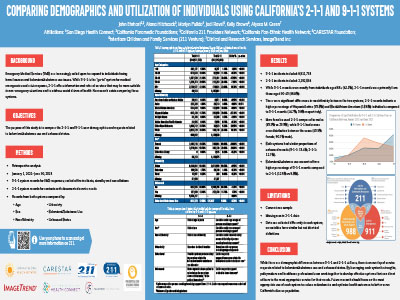ABSTRACTS
Comparing Demographics and Utilization of Individuals Using California's 2-1-1 and 9-1-1 SystemsAuthor: John Ehrhart | | Associate Authors: Alana Hitchcock MPA, Kelly Brown, Marlyn Pulido MPH, Jodi Ravel MPH, Alyssa Green MS NRP
Background: Emergency Medical Services (EMS) often respond to individuals facing homelessness and behavioral/substance use issues. While 9-1-1 is the “go-to” system for medical emergencies, 2-1-1 offers information and referral services for resources that may be more suitable in non-emergency situations and address social drivers of health. No research exists comparing these systems. The purpose of this study is to compare the 2-1-1 and 9-1-1 user demographics and requests related to behavioral/substance use and unhoused status. Methods: In this retrospective analysis of California 2-1-1 and 9-1-1 records from January 1, 2021, to June 30, 2023, 9-1-1 system records were included for all EMS responses, excluding event standbys, fire incidents, and cancellations. 2-1-1 records were included for contacts with documented service needs. Records from both systems were compared by race/ethnicity, age, sex, urbanicity, behavioral/substance use, and unhoused status. Results: Inclusion criteria were met for 6,511,733 records from 9-1-1 and 2,152,834 records from 2-1-1. While 9-1-1 records were mostly from individuals aged 65+(42.1%), 2-1-1 records were primarily from those aged 30-49(36.6%). Additionally, there were significant differences in race/ethnicity between the two systems, with 2-1-1 records having a higher percentage of Hispanic/Latino(39.8%) and Black/African American (18.6%) individuals compared to 9-1-1 records (14.7%, 9.6% respectively). More females used 2-1-1 compared to males (69.9% vs 29.9%), while 9-1-1 had a more even distribution between the sexes(49.3% female, 50.7% male). Behavioral/substance use accounted for a higher percentage of 9-1-1 records compared to 2-1-1(12.5% vs 5.8%). However, both systems had similar proportions of unhoused records(9-1-1: 13.4%; 2-1-1: 11.7%). Conclusion: While there are demographic differences between 9-1-1 and 2-1-1 utilizers, there is an overlap of service requests related to behavioral/substance use and unhoused status. By leveraging each system’s strengths, policymakers and healthcare professionals can work together to develop effective systems that can direct utilizers to the most appropriate service for their needs. Future research should focus on the most appropriate use of each system to reduce redundancies and optimize health outcomes to better serve California’s diverse population.
|

